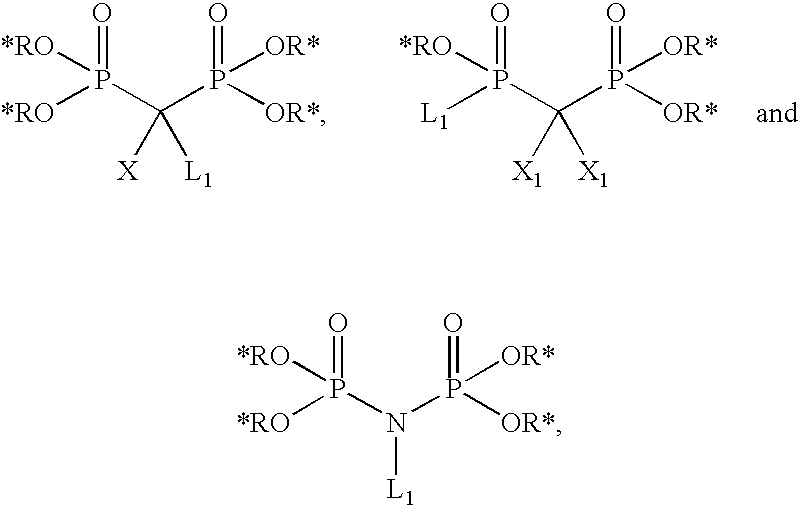Phosphonated glycopeptide and lipoglycopeptide antibiotics and uses thereof for the prevention and treatment of bone and joint infections
a glycopeptide and lipoglycopeptide technology, applied in the direction of antibacterial agents, peptide/protein ingredients, metabolism disorders, etc., can solve the problems of inconvenient treatment of osteomyelitis with teicoplanin, diabetes and kidney dialysis patients are also vulnerable, etc., to achieve the effect of increasing the binding affinity of bon
- Summary
- Abstract
- Description
- Claims
- Application Information
AI Technical Summary
Benefits of technology
Problems solved by technology
Method used
Image
Examples
example 1
Synthesis of Vancomycin and Oritavancin Bisphosphonate Conjugates
A) General Experimental Procedures
A 1) Preparation of Bisphosphonate Building Blocks
[0510]
[0511]Following protocols described in Bioorg. Med. Chem. (1999), 7: 901-919, benzyl substituted bisphosphonate building blocks of the general structures III and V can be obtained by alkylation of the anion of I with 4-substituted benzyl bromide II or bromoacetate IV. Nitro compound IIIa can be converted to aniline IIIb by reduction of the nitro group under hydrogenation conditions, using a catalyst such as PtO2. Esters like IIIc and Va can be converted to the corresponding acids IIId or Vb via ester cleavage. For example, ester IIIc where R′=t-Bu can be treated with TFA to afford the corresponding acid IIId. Under similar conditions, ester Va where X=Ot-Bu can be converted to acid Vb.
[0512]Aryl substituted methylene bisphosphonates of general formula IX can be obtained from the parent benzylic halides VI in a sequence of two Arbu...
example 2
Determination of In Vitro Antibacterial Activity
In Vitro Antibacterial Activity
[0602]Susceptibility of S. aureus strain ATCC13709 to the commercial antibiotics and synthesized compounds was determined by following the guidelines set by the Clinical and Laboratory Standards Institute (formerly the National Committee for Clinical Laboratory Standards) (M26-A). Compounds were diluted two-fold serially in either DMSO (Vancomycin 4, Oritavancin 8, compounds 10, 31, 33, 39, 44, 50, 60, 65), DMF (compounds 18 and 21) or in PBS (compound 6) and transferred to cation-adjusted Mueller Hinton broth (CAMHB; Becton Dickinson). 50 μL of compounds diluted in CAMHB was mixed with 100 μL of bacteria diluted in CAMHB in 96-well microtiter plates. The final number of micro-organisms in the assay was 5×105 c.f.u. per mL and the final concentration of DMSO or DMF in the assay, if present, was 1.25%. Assays were set up in duplicate and incubated at 37° C. for 18 h. The concentration of compound that inhi...
example 3
Binding of Compounds to Bone Powder In Vitro and Subsequent Regeneration of the Parent Drug
Bone Powder Binding
[0607]The ability of the molecules from Example 1 to bind to bone powder was established using a microbiological assay for detection. An individual compound was dissolved in PBS+2% DMSO and added at a concentration of 1 mg / ml in a slurry of bone meal powder (Now Foods, Bloomingdale, Ill., USA) in PBS at 10 mg / ml. The suspension of drug / prodrug in bone meal powder was incubated at 37° C. for 1 h to allow for binding, and centrifuged at 13 000 rpm for 2 min, before recovering the supernatant. The bone meal powder pellet was then washed three times with 1 ml of PBS+2% DMSO. The supernatant was assessed for drug content by microbioassays as follows: For vancomycin, isolated colonies of the indicator strain Bacillus subtilis 1A754 were resuspended in 0.85% saline to OD600=0.2 and spread on Cation-adjusted Miller Hinton agar (CAMHA) plates. Known volumes of the supernatants were a...
PUM
| Property | Measurement | Unit |
|---|---|---|
| Fraction | aaaaa | aaaaa |
| Fraction | aaaaa | aaaaa |
| Fraction | aaaaa | aaaaa |
Abstract
Description
Claims
Application Information
 Login to View More
Login to View More - R&D
- Intellectual Property
- Life Sciences
- Materials
- Tech Scout
- Unparalleled Data Quality
- Higher Quality Content
- 60% Fewer Hallucinations
Browse by: Latest US Patents, China's latest patents, Technical Efficacy Thesaurus, Application Domain, Technology Topic, Popular Technical Reports.
© 2025 PatSnap. All rights reserved.Legal|Privacy policy|Modern Slavery Act Transparency Statement|Sitemap|About US| Contact US: help@patsnap.com



